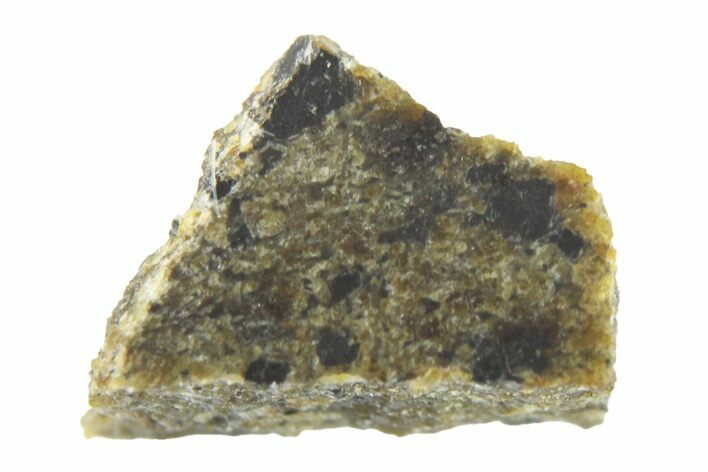This Specimen has been sold.
Martian Meteorite (68 mg) Slice - NWA 12269
This is a 4.25-millimeter wide (68 milligrams) slice of the rare Martian meteorite NWA 1195. This basaltic shergottite still contains a ton of detail for such a small specimen: several distinct olivine crystals can be seen against they gray matrix. This meteorite's high-pyroxene composition helped researchers differentiate shergottites from other Martian meteorite classes.
This specimen comes with an acrylic display case.
This specimen comes with an acrylic display case.
About Martian Meteorites (Shergottites)
Martian meteorites are rocks that formed on Mars before being ejected due to asteroid impacts, traveling through space and landing on Earth as meteorites. As you might expect, Martian meteorites are quite rare, representing less than 0.5 percent of all classified meteorites. The total mass of all known Martian meteorites is only several hundred kilograms. Superficially, Martian meteorites look very similar to igneous rocks on Earth, so nearly all have been identified from regions naturally devoid of rocks like sandy deserts (Sahara Desert and Oman) and the Antarctic ice sheets.
The achondrite meteorites are subdivided into three classes; shergottites, nakhlites, and chassignites, which together are referred to as the SNC group of meteorites. These meteorites are interpreted as Martian in origin because they have elemental and isotopic compositions similar to rocks and atmospheric gasses on Mars.
Roughly three-quarters of all Martian meteorites can be classified as shergottites. Shergottites are igneous rocks of mafic to ultramafic lithology that may have crystallized as recently as 180 million years ago. This is unusual, since most of the surface of Mars appears to be ancient, and the planet itself is rather small. Because of this, some believe that shergottites are actually much older. This "Shergottite Age Paradox" remains unsolved and is still an area of active research and debate.
Martian meteorites are rocks that formed on Mars before being ejected due to asteroid impacts, traveling through space and landing on Earth as meteorites. As you might expect, Martian meteorites are quite rare, representing less than 0.5 percent of all classified meteorites. The total mass of all known Martian meteorites is only several hundred kilograms. Superficially, Martian meteorites look very similar to igneous rocks on Earth, so nearly all have been identified from regions naturally devoid of rocks like sandy deserts (Sahara Desert and Oman) and the Antarctic ice sheets.
The achondrite meteorites are subdivided into three classes; shergottites, nakhlites, and chassignites, which together are referred to as the SNC group of meteorites. These meteorites are interpreted as Martian in origin because they have elemental and isotopic compositions similar to rocks and atmospheric gasses on Mars.
Roughly three-quarters of all Martian meteorites can be classified as shergottites. Shergottites are igneous rocks of mafic to ultramafic lithology that may have crystallized as recently as 180 million years ago. This is unusual, since most of the surface of Mars appears to be ancient, and the planet itself is rather small. Because of this, some believe that shergottites are actually much older. This "Shergottite Age Paradox" remains unsolved and is still an area of active research and debate.
TYPE
Shergottite
LOCATION
Northwestern Africa
SIZE
4.25 x 2.9 x 2.6mm, Weight: 68 milligrams
CATEGORY
ITEM
#265950
 Reviews
Reviews












